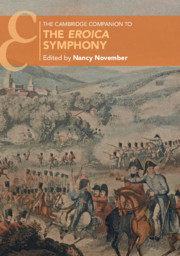Book contents
- The Cambridge Companion to the Eroica Symphony
- Cambridge Companions to Music
- The Cambridge Companion to the Eroica Symphony
- Copyright page
- Contents
- Illustrations
- Musical Examples
- Notes on Contributors
- Eroica Chronology, 1770–2020
- Acknowledgements
- Introduction
- Part I Context and Genesis
- 1 Beethoven and Heroism in the Age of Revolutions
- 2 Beethoven’s ‘Watershed’? Eroica’s Contexts and Periodisation
- 3 The Symphony in Vienna and Abroad around 1800
- 4 Genesis and Publication of the Eroica
- Part II Analytical Approaches
- Part III Reception
- Further Reading
- General Index
2 - Beethoven’s ‘Watershed’? Eroica’s Contexts and Periodisation
from Part I - Context and Genesis
Published online by Cambridge University Press: 04 June 2020
- The Cambridge Companion to the Eroica Symphony
- Cambridge Companions to Music
- The Cambridge Companion to the Eroica Symphony
- Copyright page
- Contents
- Illustrations
- Musical Examples
- Notes on Contributors
- Eroica Chronology, 1770–2020
- Acknowledgements
- Introduction
- Part I Context and Genesis
- 1 Beethoven and Heroism in the Age of Revolutions
- 2 Beethoven’s ‘Watershed’? Eroica’s Contexts and Periodisation
- 3 The Symphony in Vienna and Abroad around 1800
- 4 Genesis and Publication of the Eroica
- Part II Analytical Approaches
- Part III Reception
- Further Reading
- General Index
Summary
Critics have often described Beethoven’s Eroica Symphony as a ‘watershed’ work, not only within his career and oeuvre, but also within the histories of music, art and ideas. However, the concept of the ‘watershed’ work needs to be understood both as an aesthetic construct and as a literary device that helps to shape a narrative of triumph over adversity. Investigating this concept means disentangling the Eroica from the many stories that have been told about it since Beethoven’s death. While modern critics have made compelling claims about the Eroica’s departures from generic and stylistic norms, for instance, these claims are complicated by close engagement with the music of Beethoven’s predecessors. Carl Friedrich Michaelis’s 1805 interpretation of the symphonies of Haydn, Mozart and early Beethoven as ‘heroic epics’ ‘Heldengedichte’ offers further evidence that the Eroica reaffirmed and reimagined ‘rather than overturned’ an existing aesthetic paradigm. The Beethoven myth has strongly shaped the way the Eroica has been understood, so that beginning in the 1830s, the symphony’s extraordinary reputation has been closely bound up with the periodisation of Beethoven’s life and works. Recent scholarship on Beethoven’s ‘middle’ or ‘heroic’ period opens up alternate ways of thinking about the Eroica’s ‘watershed’ status.
Keywords
- Type
- Chapter
- Information
- The Cambridge Companion to the Eroica Symphony , pp. 24 - 42Publisher: Cambridge University PressPrint publication year: 2020



